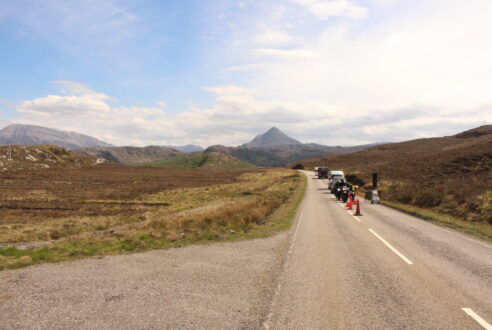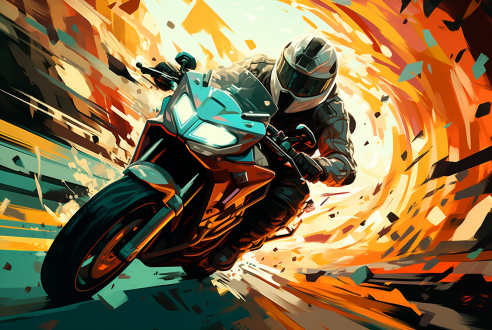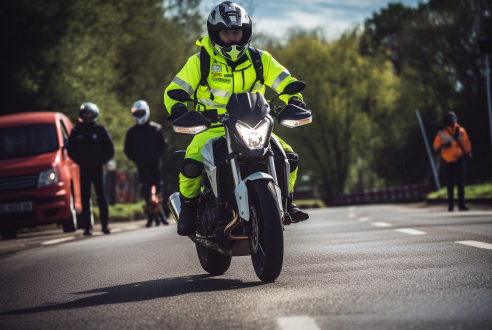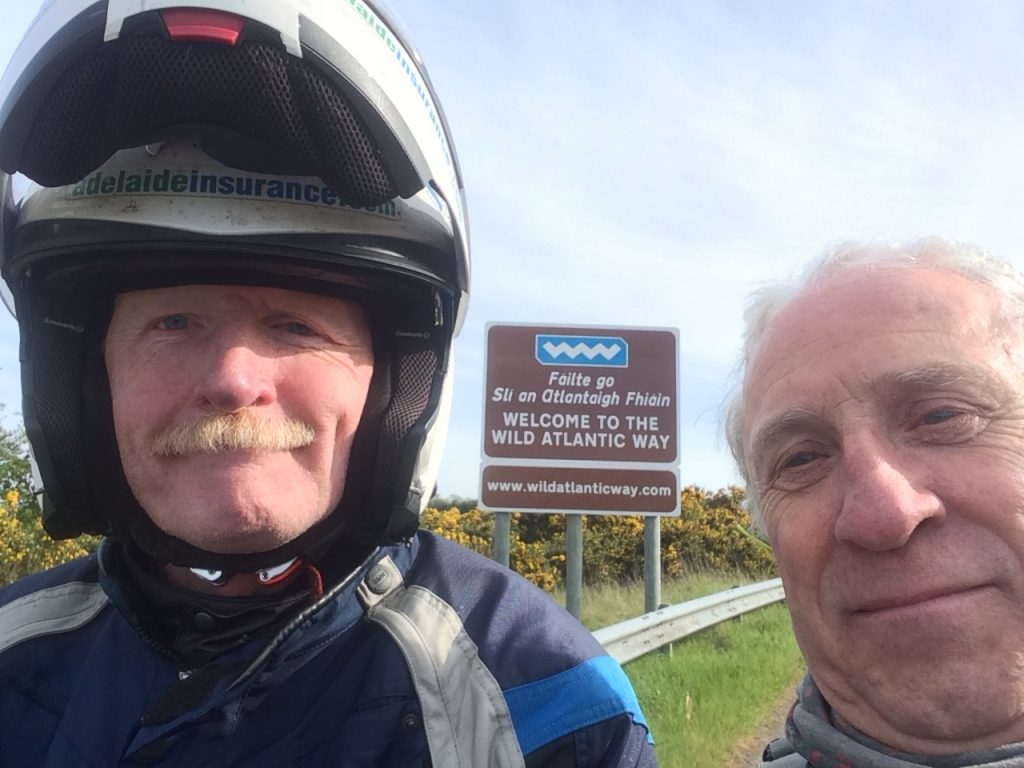
If you’re wondering which clothes to bring to the west of Ireland, the answer is all of them.
You may have been fooled by tourist board photos of Kerry teenagers sitting outside a pub in T-shirts enjoying the gentle caress of hailstones on their forearms, but I speak from the experience of having gone out too many times under blue skies in light biking gear, then looked up in horror as the heavens emptied.
Mark Twain allegedly said that if you don’t like the weather in Ireland, just wait five minutes, and he’s usually right, but I still wake up screaming in the night with memories of a five-day trip up the Wild Atlantic Way along the west coast with biking buddy Peter Murtagh of the Irish Times.
Want to guess who hadn’t checked the forecast and set off with his waterproof linings safely tucked up in the wardrobe at home?
Want to guess how many day’s torrential rain we got? I’ll give you a clue. Four. Oh wait; except for the couple of hours when a howling gale blew the rain away. And me almost off the road several times.
Still, at least on the trip I heard the most beautiful words a woman’s ever uttered to me.
Not: “I love you”. No, it was when we squelched into a hotel and the receptionist said: “We’ve got a drying room if you need it.”
She had me at drying.
The WAW, as it’s known to its friends, is a brilliant concept. With the roads already there, all the tourist board had to do was signpost the 1553 miles of highways and byways between Mizen Head and Malin Head, set up a website, and hey presto: an instant tourist attraction billed as the longest coastal route in the world – even if we only had time for a four-day taster from Kinsale to Rossnowlagh.
That’s the good news.
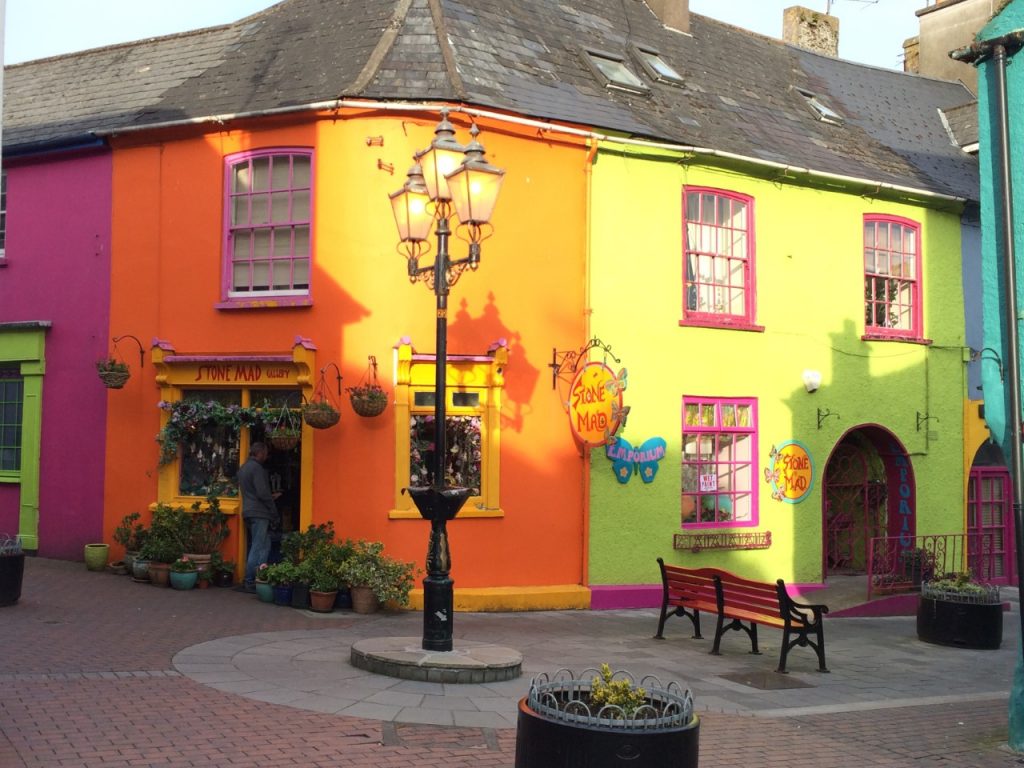
The bad news is that on the first day out of Kinsale it was raining so hard that the raindrops were bouncing off the road and passing their mates still on the way down. And the temperature was hovering not far above freezing. In May.
And when I’d loaded up the bike in Kinsale this morning in pouring rain, I got my head so wet that it was now steaming up my visor so that I had to ride with it open.
The great thing about travelling about motorbike, you see, is that at its best it’s like being a kid on a pushbike on the summer holidays.
Shorn of all the possessions and worries that bog down adult life, you have nothing more to think about every day than to throw a few things in your panniers and head off down the road, not having a clue what the day will bring.
It’s a perfect antidote to the predictability of everyday life.
Also, as Robert Pirsig said in Zen and the Art of Motorcycle Maintenance, in a car you’re observing your environment, but on a bike you’re in it: smelling the frying bacon from that café, the sweet tang of the pine forest you’re passing through or the salty smack of the sea.
Or, in my case at this moment, feeling the environment stabbing my face with a thousand needles and trickling in icy torrents down my legs into my boots. Yes, I was getting quite enough environment to be going on with, thanks for asking.
Oh well, at least I was on a bike I loved: a Triumph Tiger 800 XCx which was the sweetest handling machine in the known universe.
Soaked and frozen, I followed Peter up the narrow, winding road of Old Head to the 17th Century lighthouse, but all we could see was a grey shape thrusting up into the murk as if aching for blue skies.
I knew the feeling. We took a selfie of us looking like extras in The Underwater World of Jacques Cousteau, and rode on through a dimly glimpsed paradise of colourful villages, thatched farmhouses, dripping woods, soaring mountains and crashing waves.
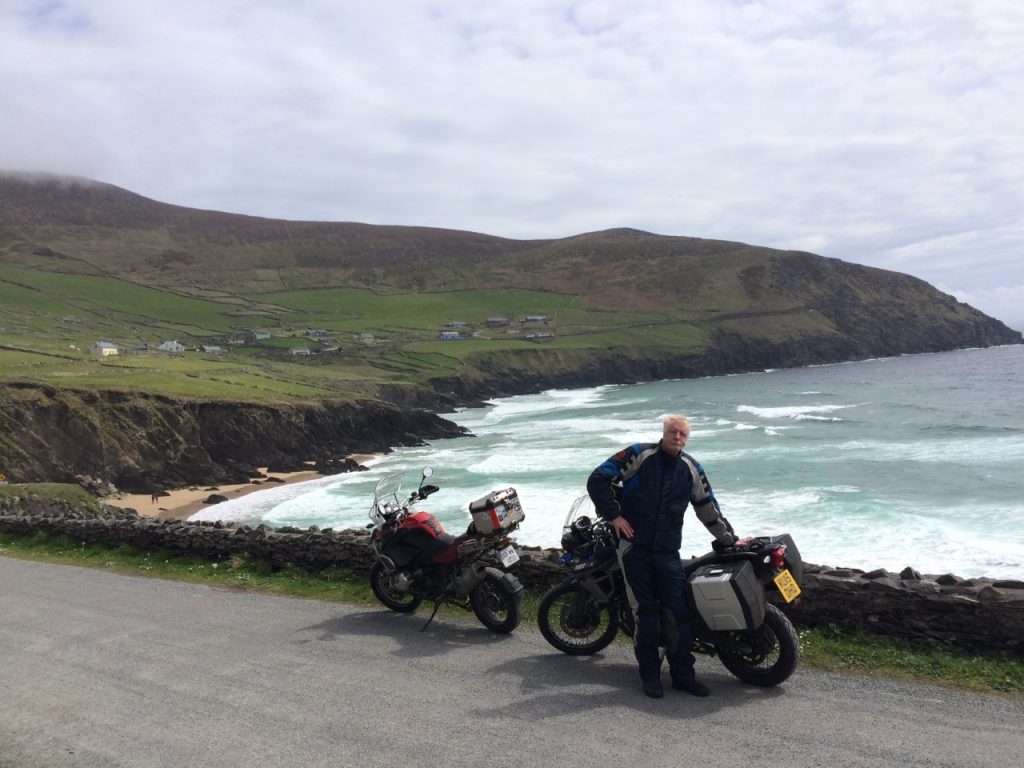
As we arrived in Dingle, the sun came out. Naturally.
I got off the bike and stood there dripping as Noel O’Leary, the man from Irish Adventures, came walking over.
“Ready for kayaking?” he said.
“Well, if I fall in, I can’t get any wetter,” I said.
And so, after the rigours of the morning, we spent a very pleasant couple of hours paddling around in the company of a hen party from Dublin and Fungi the dolphin, leaping out of the water for us and doing a couple of backflips at no extra charge. Fungi, that is, not the hen party.
Even better, Peter and I were in a twin kayak, with him up the front, so he couldn’t see that he was doing all the work while I admired the view.
“Peter, do you realise Geoff’s not paddling?” Noel called across.
“I was having my suspicions,” muttered Peter darkly.
However, he cheered up later when we went exploring in Dingle town and found the best pub then restaurant of the entire trip.
The pub was Dick Mack’s, a former spirit grocer’s dating from 1899 and now a tiny haven outside which the name plaques in the pavement showed that everyone from Julia Roberts and Dolly Parton and Robert Mitchum had called in to have a pint or try the astonishing selection of Irish whiskies behind the bar.
And just up the street from that was The Global Village, with a tasteful interior, friendly and knowledgeable staff, and a six-course tasting menu which was better than I’ve eaten in some Michelin-starred restaurants.
At one stage, Martin Bealin came wandering out from the kitchen dressed in whites.
“Are you the chef, by any chance?” I said.
“No, the plumber. I called in to fix a leak and they made me wear this,” he said, proving his wit is as inspired as his cooking.
Fed and watered, we woke the next day to sunshine and showers for a spin around Slea Head past the beach where Sarah Miles cavorted in Ryan’s Daughter.
Dry and happy, we popped in for a snack in Kruger’s Pub, whose walls were festooned with photos of the cast and crew, then gloried in the sinuous symphony of curves and dips over the Conor Pass to the ferry from Tarbert to Killimer.
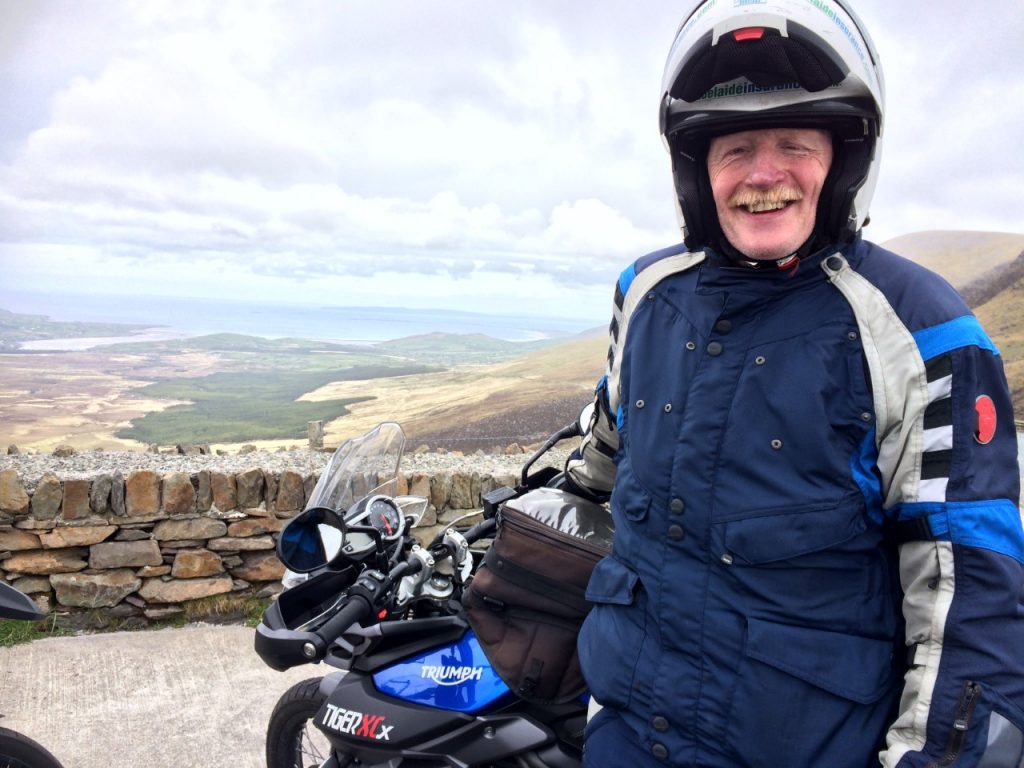
Strange, even riding off the boat after a 20-minute hop felt like an adventure to other lands, as we rode past Kilkee’s ornate and flamboyantly painted Stella Maris Hotel in Kilkee and on through Technicolor villages to Doolin for the night.
Hurrah for the Germans and Dutch who brought imagination and tins of paint decades ago, and ended the dreary habit of leaving buildings here grey under a matching sky.
The weather, of course, was only mocking us with its sunny spells, which is why the next morning, I found myself halfway up a cliff face in a downpour, in motorbiking gear, with Brian Bateson from Lahinch Adventures encouraging me to go just a bit higher.
“Geoff, there’s a good foothold to your left,” he said encouragingly.
“What, you mean that sliver of rock the size of a pencil?” I said disbelievingly.
At the Cliffs of Moher, we were the only visitors apart from a party of Japanese tourists in bright waterproof capes, fluttering about like butterflies and taking urgent photographs of each other as if they feared they were about to suddenly become extinct.
Somewhere out there were the Aran Islands, and somewhere up there was the top of O’Brien’s Tower, lost in cloud.
We rode on, through the moonscape of the Burren, and if you think it’s bleak in sunshine, you want to see it in pouring rain.
At one point I saw dripping signs emerge from the murk promising the various delights of perfumiers and chocolatiers, and imaged I must be hallucinating due to continuous organic waterboarding.
Even so, the brooding magnificence of slopes, woods, lakes and waterfalls of the Delphi Gap and the road running around Doo Lough was breathtaking, despite the weather.
By teatime we were in Belmullet in northern Mayo, where the cheery receptionist uttered the most beautiful words known to mankind: “Yes, we have a drying room.”
Warm and dry, we emerged the next morning to find a howling gale, which had at least blown the torrential rain away, hopefully to somewhere useful like the Sahara.
Blown from pillar to post and back again, we rode to Strandhill and found ourselves soaking again, although thankfully this time in a seaweed bath at Voya, started as a tiny family business by Neil Walton 15 years ago and now exporting its products to 42 countries where customers are rejuvenated by the iodine and alginate gel derived from bladder wrack.
After the rigours of the past few days, it was wonderfully indulgent to be steamed gently to open your pores, then lower yourself into a warm, oily bath of seaweed and just lie there doing nothing for half an hour.
I was still wet, but at least I was warm, and emerging feeling like we’ve been spring cleaned, we grabbed a tasty smoked salmon bagel in the Shells Café next door and rode on recharged to Rossnowlagh, where I’d spent family holidays as a child in a damp caravan in the corner of a field, listening to the rain patter on the roof and playing Monopoly and Spot the Earwig.
This time around, things were a lot better, staying at the grand Sandhouse Hotel and tucking into mussels and lamb shanks in the cosy and busy Smuggler’s Creek overlooking the bay.
Sitting there as the sun went down in a blaze of glory, I looked down at the glorious crescent of beach where my sisters and I built sandcastles as children, raised a glass to our tiny, imagined selves, and wondered where all the years have gone.
Washed away by rain, I imagine.
Still, as I looked back on the ride, even though we’d only done about 600 miles of it in appalling weather, it was up there with the Pacific Coast Highway in the USA and the Great Ocean Road in Australia as one of the world’s great coastal routes. It’s certainly increased tourist numbers, according to everyone we talked to.
So I plan to go back and do it again. Except this time I’m going to look at the forecast.
Now if you’ll excuse me, I’m going to sit in a sauna for a while and steam gently. I expect to be dry by Christmas.
The route
If you want to do the entire Wild Atlantic Way from Kinsale to Malin Head in Donegal, say goodbye to the cat for a while: including all the squiggly bits, it’s a whopping 1,553 miles, making it the longest coastal road in the world.
However, both the main routes and side ones are brilliantly signposted with the inspired WAW logo, so you can take as little as five days if you mix and match routes. Details at www.discoverireland.ie and www.wildatlanticway.com.
Insurance
You’ll need a green card since Brexit, so get one free from your insurance company.
Where to stay
The stylish Trident Hotel, in Kinsale, the sprawling Dingle Skellig Hotel, in Dingle, cosy Cullinan’s Guest House, with its award-winning restaurant, in Doolin, the exuberantly colourful boutique Talbot Hotel, in Belmullet, or the imposing beachside Sandhouse Hotel, in Rossnowlagh.
Top things to try
Kayaking in Dingle Bay with the friendly and erudite Noel O’Leary of Irish Adventures, while Fungi the dolphin gambols around you – that’s if he ever returns, since at the time of writing he’d vanished for two months, and fears are growing that he may not be alive.
Tours are about three hours, including popping into and out of caves.
Others are rock climbing with Lahinch Adventures, www.benssurfclinic.com/rock-climbing in Doolin, or surfing with Fin McCool’s Surf School, in Rossnowlagh.
Where to eat
The Global Village in Dingle. Try the €65 per person six-course taster menu, or €100 with wine, and stand by for an exquisite treat washed down by a bottle from a well-chosen and eclectic list.
And finally…
Remember your instructor’s advice to always go around a corner as if there was a tractor parked on the other side, because one day there would be?
Remember it on rural Ireland B-roads, because there will be. Or if not a tractor, a sheep or two farmers having a natter.

